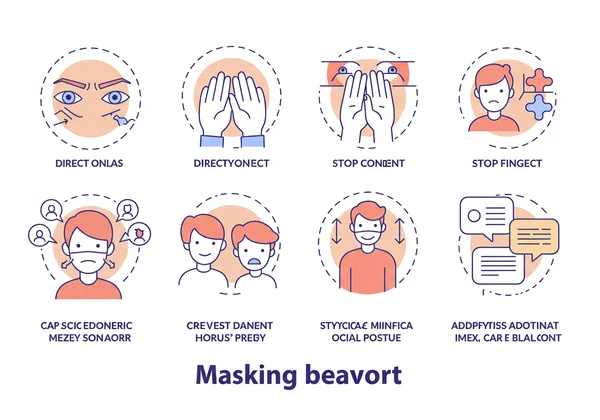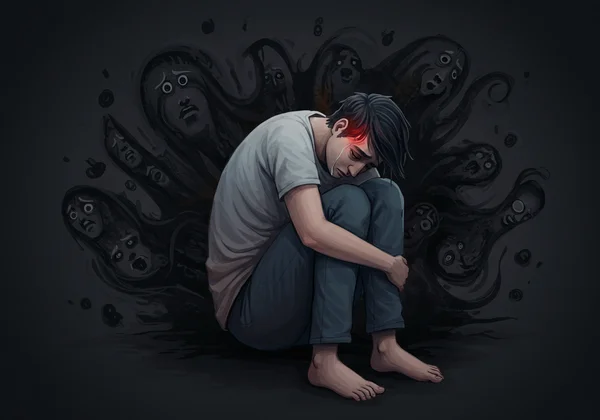Neurodivergent Masking: The Burnout Cost of Hiding Your True Self
Do you feel a deep, unshakable exhaustion after social interactions, even ones you wanted to attend? Do you constantly feel like you're playing a part, carefully choosing your words and actions to fit in with those around you? This experience is known as neurodivergent masking, the conscious or subconscious practice of hiding one's natural traits to appear more "neurotypical."
While masking can feel like a necessary survival tool, it comes with a significant cost: neurodivergent burnout. This isn't just feeling tired; it's a profound state of emotional, mental, and physical depletion caused by the constant strain of suppressing your authentic self. So, how can you stop paying this price? This guide explores the deep link between masking and burnout and offers the first steps toward safely unmasking and reclaiming your identity.

What Is Neurodivergent Masking?
Neurodivergent masking, also called camouflaging, is the act of concealing or compensating for neurodivergent traits to meet societal expectations. It's a complex performance developed to navigate social settings, avoid judgment, and succeed in environments—like schools and workplaces—that are often designed for neurotypical brains.
This process can be both deliberate and automatic. You might actively force yourself to make eye contact or consciously stop yourself from stimming (self-stimulating behaviors). Over time, masking can become so ingrained that you may not even recognize you’re doing it. It simply becomes your default way of existing in the world, driven by a fundamental human need for safety, acceptance, and connection. From a young age, many neurodivergent people are taught that their natural behaviors are "wrong," leading them to believe that hiding is the only path to acceptance.
Telltale Signs of Neurodivergent Masking
Masking manifests differently for everyone, but it often involves a common set of exhausting performances. Recognizing these patterns in yourself is the first step toward understanding their impact.
Here are some common examples of masking:
-
Forcing or faking eye contact: Enduring physical discomfort or difficulty processing conversations to appear engaged.
-
Suppressing stimming: Actively stopping repetitive movements like hand-flapping, rocking, or leg-jiggling that are used to regulate emotions and sensory input.
-
Mimicking social behaviors: Consciously copying the body language, tone of voice, and facial expressions of others to blend in.
-
Scripting conversations: Mentally rehearsing what to say beforehand or relying on a list of pre-prepared phrases and jokes in social situations.
-
Hiding special interests: Downplaying or completely avoiding talking about deep, passionate interests for fear of being seen as "weird" or "obsessive."
-
Pushing through sensory overload: Tolerating overwhelming environments (like loud parties or bright stores) without showing any outward signs of distress.

Noticing these behaviors without judgment is a crucial act of self-awareness. An am I neurodivergent test can often provide a framework that helps illuminate the very traits you've worked so hard to conceal.
The Link Between Masking and Neurodivergent Burnout
Imagine running a demanding software program in the background of your mind all day, every day. Eventually, your internal system will slow down, overheat, and crash. This is the effect that ADHD masking and autistic masking have on the brain. The constant mental energy required to maintain this performance is unsustainable and leads directly to burnout.
Neurodivergent burnout is a severe state of chronic exhaustion that cripples your ability to function. It’s more than stress; it’s the complete depletion of your internal resources, drained by the cumulative effort of camouflaging your true self while navigating a world not built for you. Your capacity for daily tasks, work, and even basic self-care plummets.
Autistic Burnout vs. ADHD Burnout: Key Differences & Shared Experiences
While both stem from profound exhaustion, understanding the nuances between autistic and ADHD burnout can be validating.
- Autistic Burnout often involves a significant loss of skills. Abilities you once had, like socializing or managing daily tasks, may feel impossible. It can also bring heightened sensory sensitivity, an intense need for solitude, and a shutdown of social and communication capabilities.
- ADHD Burnout frequently manifests as extreme executive dysfunction. The "wall of awful"—the paralyzing inability to start tasks—can feel insurmountable. It may also involve severe emotional dysregulation, memory loss, and a deep sense of being overwhelmed.
Despite these differences, the core experience is one of total depletion. It feels like hitting a wall, with no energy left for anything—least of all, the mask.
How Masking Impacts Mental and Physical Health
The long-term consequences of masking and burnout are severe. The constant self-monitoring fuels anxiety and imposter syndrome. This disconnect from your authentic self can also lead to depression, creating a deep sense of loneliness and alienation.
Physically, the chronic stress of masking takes a toll on the body. It can weaken the immune system and contribute to chronic fatigue, digestive issues, migraines, and increased pain sensitivity. Your body carries the burden of the performance. Understanding your traits with a neurodivergent traits quiz is a vital first step toward preventing this steep decline in your well-being.

How to Start Unmasking Safely
The thought of unmasking neurodivergent traits can be frightening. Your mask was created as a shield, and lowering it will feel vulnerable. This is why the unmasking process must be gradual, intentional, and centered around your safety. It’s not about revealing everything to everyone at once, but about creating small, secure spaces where you can be authentic.
1. Self-Awareness: Identify Your Masks
You can't take off a mask you don't realize you're wearing. Begin with gentle observation.
- Notice which situations or interactions leave you feeling most drained.
- Ask yourself: What social "rules" am I forcing myself to follow?
- Keep a journal to track how you feel before, during, and after social events. Note when you feel you're "performing" the most.
This practice of self-acceptance starts by simply noticing your patterns without judgment.
2. Cultivate Safe Spaces and Authentic Connections
Unmasking is safest with people you trust.
- Identify your allies: Who in your life is accepting and non-judgmental? This could be a friend, partner, or family member.
- Start small: With a trusted person, try letting one part of the mask slip. For example, allow yourself to look away during a conversation to better process what they're saying, or share a small fact about a special interest.
- Find your community: Online groups for neurodivergent individuals can be a powerful source of validation. Connecting with people who share your experiences is a potent reminder that your authentic self is worthy of acceptance.
3. Seek Professional Support
A neurodiversity-affirming therapist or coach can provide essential guidance on your journey. They can help you:
- Process the grief and anger that can arise from realizing how long you've been masking.
- Develop practical strategies for setting boundaries to protect your energy.
- Build skills for self-advocacy in school, work, and personal relationships.
Remember, online screeners are tools for exploration, not diagnosis. Bringing your results from a free neurodivergent test to a professional is an excellent way to start a meaningful conversation, giving them immediate insight into your experiences.
Conclusion: Embracing Your Authentic Neurodivergent Self
Letting go of a lifetime of masking isn't an overnight fix; it's a courageous journey of self-reclamation. It is about trading the exhaustion of performance for the peace of authenticity. It requires unlearning the harmful message that you are "too much" or "not enough" and embracing the truth that your brain is different, not defective.
Your unique perspective, deep passions, and natural way of being are not flaws to be hidden—they are core parts of who you are. By understanding and honoring your neurodivergent traits, you can build a life that supports your needs instead of one that constantly fights against them.

If you're ready to begin this journey of self-discovery, we invite you to explore your unique neurotype. Our test is designed to be an empowering and accessible starting point, making exploration easier so you can make your life richer.
Frequently Asked Questions About Neurodivergent Masking & Burnout
Is It Neurodivergence, or Am I Just 'Lazy' or 'Anxious'?
This is a common and valid question. Labels like "lazy" or "anxious" are often misapplied to neurodivergent people to describe behaviors without understanding their root cause. The constant effort of masking can directly cause anxiety, while the resulting burnout often presents as "laziness" due to severe executive dysfunction. Exploring your traits with a neurodivergence test can offer a more accurate and compassionate lens for your experiences.
What are the signs of being neurodivergent that often get masked?
Many core neurodivergent traits are hidden. These include stimming (rocking, fidgeting), differences in social communication (like being direct or preferring deep talk over small talk), intense special interests, sensory sensitivities (to light, sound, touch), and non-linear thinking patterns. The process of unmasking often involves rediscovering and re-embracing these natural tendencies.
Can you be neurodivergent and not have ADHD or autism, yet still experience masking?
Absolutely. Neurodiversity is a broad umbrella that includes dyslexia, dyspraxia, Tourette's syndrome, and many other conditions. Any individual whose brain functions differently from the societal "norm" may develop masking strategies to navigate the world, leading to the same risk of burnout.
What are the strengths of a neurodivergent brain that masking might hide?
Masking often conceals incredible strengths. These can include an intense ability to focus (hyperfocus), exceptional creativity, innovative problem-solving, strong pattern recognition skills, deep empathy, and a unique, out-of-the-box perspective. Unmasking allows these powerful attributes to come to the surface and flourish.
How Can a Test Help Me Identify My Own Masking Behaviors?
A neurodivergent test can serve as a mirror, reflecting back traits and experiences you may not have had the words for. When a question describes a feeling you've always had but consistently hidden, it highlights a potential mask. The results provide a vocabulary and a framework, helping you connect the dots between your suppressed traits and your feelings of burnout. It’s a powerful first step in seeing yourself more clearly, and you can take our free test to begin that process.